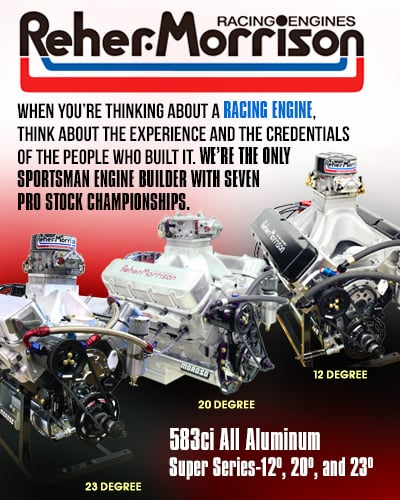CHRR HONOREES COVERED DRAG RACING IN PARALLEL UNIVERSES
California Hot Rod Reunion honorees Dave Wallace and Rick Voegelin never worked in the same


office, but they did travel in parallel universes.
"He was doing the weeklies and I was doing the monthlies," Voegelin said. "When he was at Petersen, he was at Hot Rod, I was at Car Craft. We’d do anything to beat Hot Rod to a story.
"So actually other than the fact that we used to carpool occasionally from Orange County, and would hang out together at the races, we had really very little daily interaction, although of course we knew each other and we were well aware of each other’s work. But we were always just slightly out of sync. Seven degrees of separation or something."
"We would meet at this Coco’s coffee shop, and we would talk about how even though we were in the biz and we loved doing what we were doing, we both wanted to do [advertising agency] kind of thing," Wallace added.
Wallace and Voegelin worked in what was considered by man to have been the golden ages of journalism.
"It was incredibly creative," Voegelin said. "We weren’t just doing drag racing reporting, we were also trying to do journalism. I think we were really affected by, influenced by publications like Rolling Stone, and Mother Earth News, and all the crazy stuff that was going on with journalism in the 60’s and 70’s. So that accounts for all the lead shots that we used to do, and we would spend so much time on titles. And occasionally it came out really good and creative, and occasionally it came out just really silly, but you can’t hit them all."
It might have been the golden age of drag racing journalism, but for Wallace, he believed the second generation of drag racing journalist were starting to explore their horizons to the fullest.
"The first wave guys like Eric Rickman in the 50’s, they were designing the whole occupation because there wasn’t an occupation before," Wallace explained. "We came in kind of on the tail end of that and we just figured it would always be that way.
"We just thought it’d get better and better. Maybe T.V. will come, won’t that be great? What could go wrong? Maybe we’ll get T.V. and sponsors and it will get bigger and bigger. The great thing was that the times were interesting. It was an interesting time so if you were just being a reporter, you had AHRA IHRA NHRA for a lot of that once IHRA came in.
"You had independent promoters, match races and stuff going on. It was wide open, it was a wide open deal. Nobody was suing anybody for saying something nasty about your sponsor or any of that. We had total freedom really in most cases I think. That was the beauty that I thought, was the freedom to do stuff without worrying about."
Wallace said he remembers the time seeing former National DRAGSTER staffer Chris Martin become disheartened and knew their craft was changing.
SPORTSMAN RESULTS FROM 2018 CALIFORNIA HOT ROD REUNION https://t.co/0UlnVfcU1I
— Competition Plus (@competitionplus) October 23, 2018

Today changing landscape of publishing disappoints Voegelin.
"The reality is, we were selling 250,000 copies a month on the newsstand," Voegelin recalled. "We were selling 400,000 copies a month with subscribers. I look at the newsstand stats now for magazines and they’re like not even getting in the five figures. So I understand why, it’s not the world that it was back then. We were writing on IBM Selectrics, we were taking photos on film, we had a three month lead time.
"Our coverage for the Winternationals would be in the May issue, our coverage for the U.S. Nationals would be in the December issue if we really pushed the deadline to get it in there. So, it’s a different world. We had real staffs back then. You know every magazine at Petersen was an independent business unit. We had a publisher, we had an editor, we had a managing editor, we had a copy editor, we had two, three, four staff guys, we had an art director, we had an assistant art director. Now it’s like there’s one guy who has to put the whole magazine together and if he’s lucky he might have a few thousand dollars for a freelance budget and he’s got to do the whole job. He’s sharing a managing editor, and a copy editor with four other books. And of course the books all look homogenized, they have no personality, no individuality. They’re just kind of a commodity."
Wallace has watched as the world of drag racing journalism has changed.
"There sure is a lot more of it," Wallace said. "The difference is, I think that even when Rick and I were doing it as late as the 70’s, late 70’s, everybody saw it. Whatever we did, everybody saw it in our world. Now it’s so fragmented that I could do something with CompetitionPlus.com or something with another online publication, if anybody ever saw it I wouldn’t hear about it unless I was really following social media for that. It’s really scattered now.
"Back then where before if you made a mistake, and I used to say I called a 780 Holley a 750 once, I got 30 letters about how dumb I was, at Hot Rod. And today, I don’t hear anything from anybody. We do a story in Hot Rod, I have a column at Hot Rod, two departments every month, I can’t think that anybody ever noticed either one of them to comment on.
"But at that time, it was very centralized and you knew that whatever you were doing was going to be seen by everybody in our world. Now I can’t even track all the stuff."





































